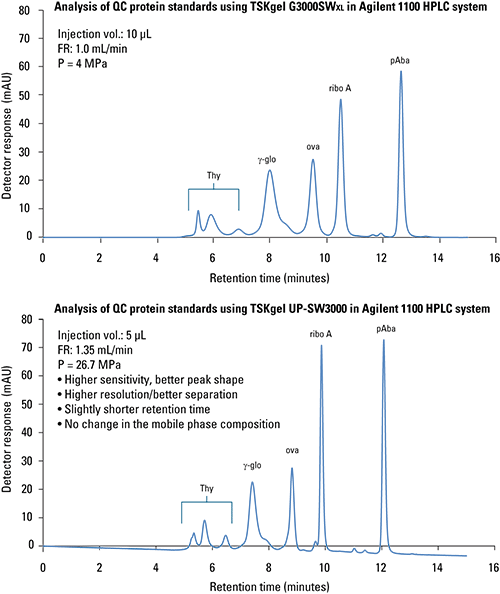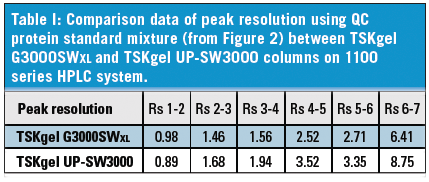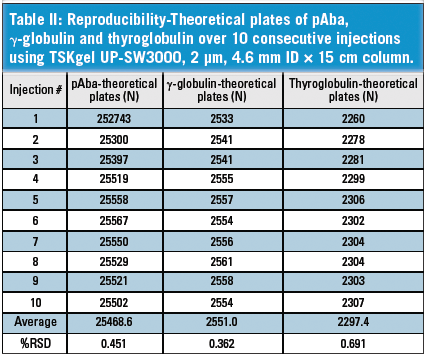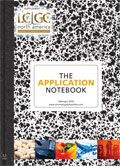Improving Resolution and Sample Throughput for Protein Analysis Using TSKgel® UP-SW3000 Columns
The Application Notebook
The peak resolution profile remained nearly unchanged. In particular, the resolution profile of thyroglobulin was similar to the resolution that was obtained by the 4.6 mm ID × 30 cm column. This suggests that the separation of high order molecular weight species, such as aggregates from mAb, can be easily achieved using this 4.6 mm ID × 15 cm column. Ten consecutive runs yielded excellent reproducibility. In fact, peaks from 10 consecutive injections were nicely overlaid.
Size exclusion chromatography (SEC) is an important method for monitoring the impurities of biotherapeutic drugs, in order to minimize the immunologic effect that may occur when such impurities are present. The SEC method is widely used to determine the monomers, dimers, aggregates, and fragments in biotherapeutic drug samples, including monoclonal antibodies (mAbs). A few of the requirements for a successful analysis include: superior resolution, excellent reproducibility and short analysis time. In order to achieve these, an SEC column must have the appropriate particle size and pore size, good bonding chemistry, and suitable column dimensions. To ease method development, SEC columns can be run using an established operating method with minimal time spent on method optimization. To enhance cost-saving measures, these columns should be packed such that they can be operated with both HPLC and UHPLC systems.
This application describes the use of TSKgel UP-SW3000 SEC columns for the analysis of proteins. These columns have a particle size of 2 µm, and are 25 nm in size. The particles are coated with a hydrophilic diol-type bonded phase in order to minimize the interaction between the silica surface and proteins. These columns are designed to be operated with a simple and well established method (sodium phosphate mobile phase, pH 6.8) and are packed for use in both HPLC and UHPLC systems. A comparasion study between a TSKgel UP-SW3000 column and a larger particle sized SEC column (when operated under the same mobile phase conditions with a slight adjustment of the flow rate) show that the TSKgel UP-SW3000 column has a higher resolution while the retention time profile of the separation remains nearly unchanged. Results from the shorter column dimension, 4.6 mm ID × 15 cm, show that the run time can be completed 2 times faster than its longer column dimension counterpart without compromising resolution and reproducibility.
Experimental Conditions

Results and Discussion
Figure 1 shows the protein standard calibration curve data that was generated using the TSKgel UP-SW3000 column. The column was run with a simple aqueous mobile phase (sodium phosphate buffer, pH 6.8) as typically reported in literature for SEC separations. The data demonstrates that the TSKgel UP-SW3000 column has a broad and linear resolving range of molecular weights. The shallow slope around the molecular weight of γ-globulin suggests that the particles of the column have an optimized pore size for the separation of proteins with a molecular weight of approximately 150 kDa.

Figure 1: Standard calibration curve of QC protein standard mixture generated by TSKgel UP-SW3000, 4.6 mm ID × 30 cm column.
Figure 2 shows comparison data between a TSKgel UP-SW3000 column (Figure 2, top) and a 5 µm particle sized SEC column (TSKgel G3000SWXL, 7.8 mm ID × 30 cm) (Figure 2, bottom) operated under the same mobile phase conditions with a slight change in flow rate. The results indicate that the TSKgel UP-SW3000 provided a major improvement in peak resolution (Table I) and peak shape, while the peak retention times remained nearly unchanged. This suggests that the TSKgel UP-SW3000 column can be compatible with the established protocol that was used for a larger particle sized SEC column, such as a TSKgel G3000SWXL column, with a slight change in flow rate. Since the TSKgel UP-SW3000 column generated a backpressure of only 26.7 MPa at a 0.35 mL/min flow rate, these columns can be used with both HPLC and UHPLC systems.

Figure 2: Comparison study between TSKgel UP-SW3000, 4.6 mm ID × 30 cm and TSKgel G3000SWXL, 7.8 mm ID × 30 cm columns using the same mobile phase condition for the separation of a QC protein standard mixture.
Figure 3 shows the elution profile of a QC protein standard mixture generated using a TSKgel UP-SW3000, 4.6 mm ID × 15 cm column operated at 0.35 mL/min. The separation was completed in only 7 min, nearly two times faster than the same column of 4.6 mm ID × 30 cm dimension. The peak resolution profile remained nearly unchanged. In particular, the resolution profile of thyroglobulin was similar to the resolution that was obtained by the 4.6 mm ID × 30 cm column. This suggests that the separation of high order molecular weight species, such as aggregates from mAb, can be easily achieved using this 4.6 mm ID × 15 cm column. Ten consecutive runs yielded excellent reproducibility. In fact, peaks from 10 consecutive injections were nicely overlaid.

Table I: Comparison data of peak resolution using QC protein standard mixture (from Figure 2) between TSKgel G3000SWXL and TSKgel UP-SW3000 columns on 1100 series HPLC system.
Results from Table II show low percentage relative standard deviation of the theoretical plates from a wide range of molecular weights within 10 consecutive injections of protein standard (from Figure 2). The data suggests that the TSKgel UP-SW3000 columns have a high reproducibility of injection after injection.

Figure 3: Ten consecutive injections of QC protein standard mixture generated using a TSKgel UP-SW3000, 4.6 mm ID × 15 cm column.
Conclusion
The above results demonstrate the broad and linear molecular weight resolving range of TSKgel UP-SW3000 columns. This, in turn, drives the accuracy, reliability and reproducibility for molecules of interest such as the monomer, dimer, and aggregates of mAbs. The comparison between a TSKgel UP-SW3000 column and a larger particle sized SEC column using the same operating mobile phase conditions showed that the TSKgel UP-SW3000 column has higher resolution. This suggests that the TSKgel UP-SW3000 column can be easily operated with an established method. The low backpressure allows TSKgel UP-SW3000 columns to be run in both HPLC and UHPLC systems. With the shorter column dimension that is available, faster analysis time can be achieved for increased sample throughput.

Table II: Reproducibility-Theoretical plates of pAba, γ-globulin and thyroglobulin over 10 consecutive injections using TSKgel UP-SW3000, 2 µm, 4.6 mm ID × 15 cm column.
Tosoh Bioscience and TSKgel are registered trademarks of Tosoh Corporation.

Tosoh Bioscience LLC
3604 Horizon Drive, Suite 100, King of Prussia, PA 19406
tel. (484) 805-1219, fax (610)
Website: www.tosohbioscience.com

SEC-MALS of Antibody Therapeutics—A Robust Method for In-Depth Sample Characterization
June 1st 2022Monoclonal antibodies (mAbs) are effective therapeutics for cancers, auto-immune diseases, viral infections, and other diseases. Recent developments in antibody therapeutics aim to add more specific binding regions (bi- and multi-specificity) to increase their effectiveness and/or to downsize the molecule to the specific binding regions (for example, scFv or Fab fragment) to achieve better penetration of the tissue. As the molecule gets more complex, the possible high and low molecular weight (H/LMW) impurities become more complex, too. In order to accurately analyze the various species, more advanced detection than ultraviolet (UV) is required to characterize a mAb sample.














